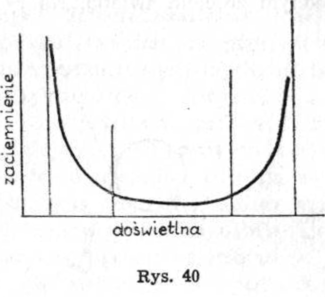SEMI-SHADE
The quantitative brightness of the light falling on the surface of an object depends on four factors, namely:
1. brightness of the light source,
2. number of light sources,
3. distance of the light source from the object,
4. angle of incidence of light on the surface.
At the moment, we are particularly interested in points 3 i 4.
The greater the distance between the light source and the object, the less the subject is illuminated. The decrease in the amount of illumination is proportional to the square of the distance between the light source and the object.
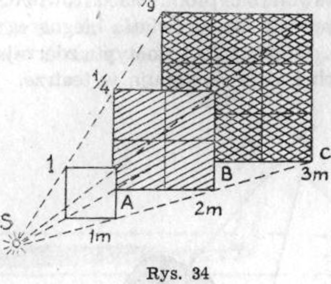 Drawing 34 the physical law explains it. The same amount of light illuminates from a distance 3 meters surface 9 times greater, and from a distance 2 meters - 4 times greater than the distance 1 metra.
Drawing 34 the physical law explains it. The same amount of light illuminates from a distance 3 meters surface 9 times greater, and from a distance 2 meters - 4 times greater than the distance 1 metra.
The brightness of the surface illumination also depends on the angle at which the light falls on it.
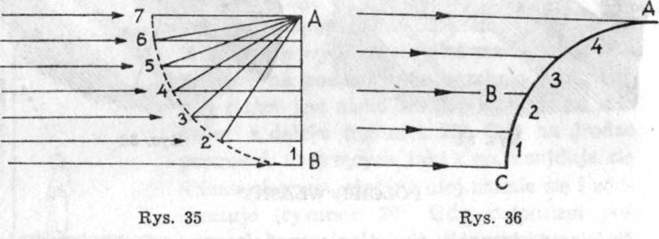 In the drawing 35 rotating on axis A surface AB at position 1 accepts 6 light units, in position 2 — 5 units etc. In position 6 Just 1 unit, and in position 7 The light glides over her without illuminating her at all.
In the drawing 35 rotating on axis A surface AB at position 1 accepts 6 light units, in position 2 — 5 units etc. In position 6 Just 1 unit, and in position 7 The light glides over her without illuminating her at all.
This issue, relatively simple on flat surfaces, becomes more complicated with rounded surfaces, np. when illuminating the surface of the cylinder. Arc ABC in the drawing 36 constitutes 1/4 cylinder surface. We divide it into four sections 1, 2, 3 i 4, of which the segment is the smallest 1, and the largest section 4. Because each of these sections is illuminated by the same amount of light, episode 1, shortest - will be lit the brightest, and the longest section 4 - the weakest. For this reason, the light part of the field of rounded figures is never evenly illuminated.
A cylinder illuminated with "perfectly" non-diffused light would have a uniformly black illuminating side, and the illuminating side is gently toned. The transition from light to shadow would be almost abrupt in this case, but having a narrow transition zone, which is not a proper penumbra, because undiffused light cannot create penumbra. A similar phenomenon occurs on the moon on the terminator (the border of day and night). The sun can be treated here as a source of non-scattered light. We can't see the penumbra here through a telescope, and only a grainy transition from shadow to light. It is caused by the unevenness of the moon's surface. This is a typical example of a granular transition. Grainy transitions are also called grainy midtones. Substantially, from a distance, from which grain elements are not distinguished, they give the impression of half-shade.
Using diffused light, we get partial shade. Because it is impossible to obtain perfectly unscattered light, penumbra always arises. In practice, it is often so small, that we do not take into account.
As we already know, the size of the penumbra depends on the size of the lighting angle.
Penumbra is created on flat surfaces, illuminated by a single light source, at a suitable distance from the object.
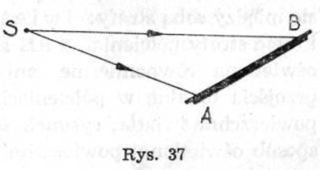 Distance doesn't play a role here, how much is the ratio of the distance of the light source from the nearest and farthest (drawing 37 on : SB) point of the illuminated plane. When this ratio is not greater than 1:1,1, the difference in brightness will not be noticeable. With intercourse 1:1,2 may be insignificant, with intercourse 1 :1,3 will be eye-catching, and in high-contrast photos it can be annoying.
Distance doesn't play a role here, how much is the ratio of the distance of the light source from the nearest and farthest (drawing 37 on : SB) point of the illuminated plane. When this ratio is not greater than 1:1,1, the difference in brightness will not be noticeable. With intercourse 1:1,2 may be insignificant, with intercourse 1 :1,3 will be eye-catching, and in high-contrast photos it can be annoying.
The surface of a properly illuminated polyhedron (drawing 38) it will be a series of planes, tonally different from each other.
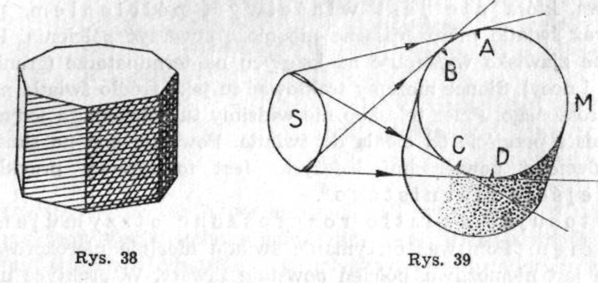 Matt cylinder, illuminated with diffused light, even with a relatively small beam angle, will have a clearly differentiated lighting surface. The illuminating one will be evenly dark (drawing 39, AMD). We see our own shadow on it, unless another light source is involved, np. residual lighting. The luminosity ABCD will be divided into three distinct zones: luminous BC, still called "light", and two penumbra zones - AB and CD. None of these zones will be illuminated evenly, nor light, nor partial shade, however, tonal transitions in the mid-shadows will be much more abrupt than in the light surface; drawing 40 shows the light curve of the thus illuminated surface of the matte cylinder.
Matt cylinder, illuminated with diffused light, even with a relatively small beam angle, will have a clearly differentiated lighting surface. The illuminating one will be evenly dark (drawing 39, AMD). We see our own shadow on it, unless another light source is involved, np. residual lighting. The luminosity ABCD will be divided into three distinct zones: luminous BC, still called "light", and two penumbra zones - AB and CD. None of these zones will be illuminated evenly, nor light, nor partial shade, however, tonal transitions in the mid-shadows will be much more abrupt than in the light surface; drawing 40 shows the light curve of the thus illuminated surface of the matte cylinder.
